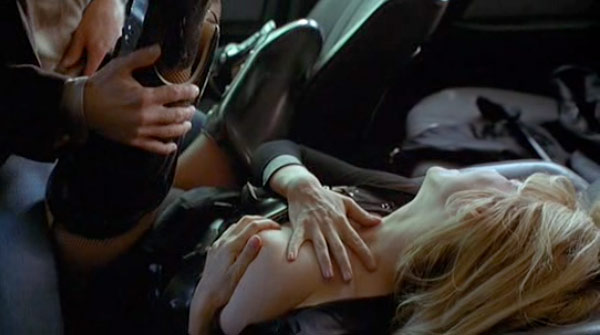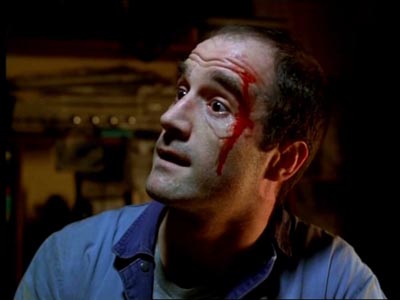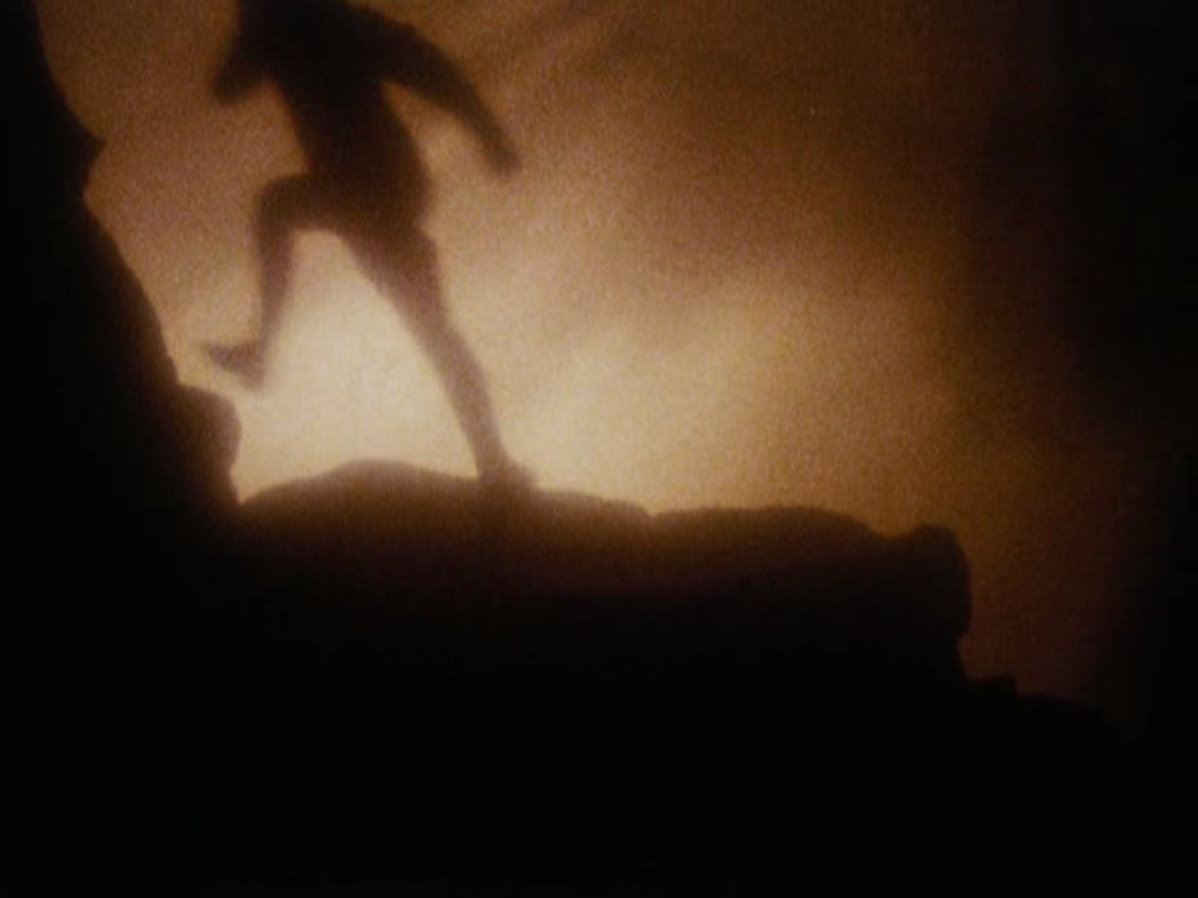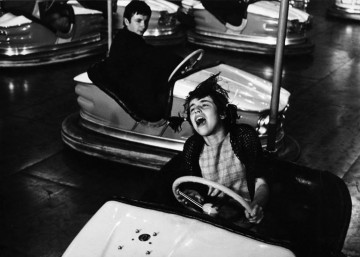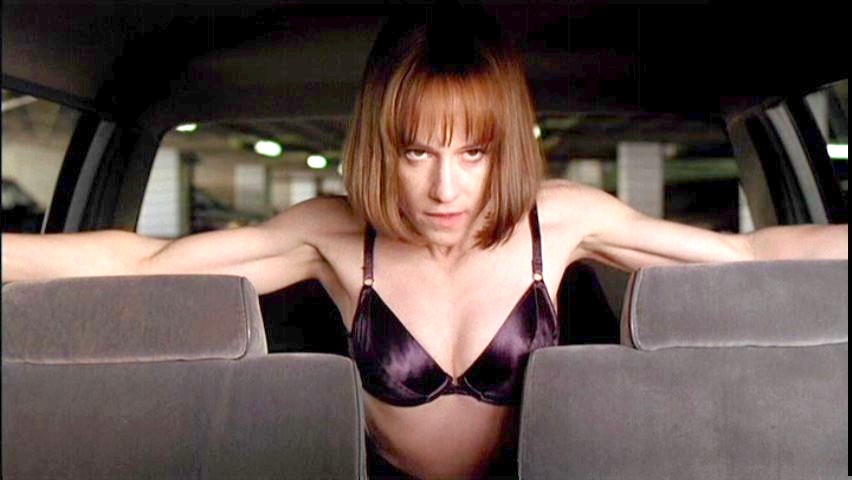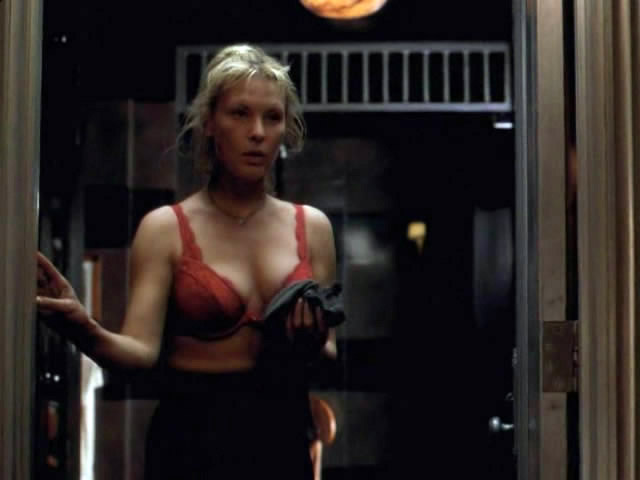From the Chicago Reader (March 21, 1997). — J.R.
CRASH
Rating *** A must see
Directed and written by David Cronenberg
With James Spader, Deborah Kara Unger, Holly Hunter, Elias Koteas, Rosanna Arquette, Peter MacNeill, Yolanda Julian, and Cheryl Swarts.
“Throughout Crash I have used the car not only as a sexual image, but as a total metaphor for man’s life in today’s society. As such the novel has a political role quite apart from its sexual content, but I would still like to think that Crash is the first pornographic novel based on technology. In a sense, pornography is the most political form of fiction, dealing with how we use and exploit each other in the most urgent and ruthless way.
“Needless to say, the ultimate role of Crash is cautionary, a warning against that brutal, erotic and overlit realm that beckons more and more persuasively to us from the margins of the technological landscape.”
These are the last two paragraphs of J.G. Ballard’s introduction to his 1973 novel Crash. They point to a seeming paradox that lies at the heart of David Cronenberg’s masterful film adaptation as well as the original — the idea that pornography, by virtue of being political, can play a cautionary role rather than, or in addition to, a prescriptive one.
This paradox helps explain why almost a year has passed between the premiere of Crash at Cannes and its stateside release. Of course a year or more usually passes between the time a foreign-language movie shows at Cannes and its U.S. release, mainly because there aren’t enough independent theaters left in this country to show all the foreign pictures that acquire distributors; these movies have to stand in line, the way spectators often have to stand in line to see more commercial films. But even though Ballard’s novel and Cronenberg’s film are in English, both might be said to speak a foreign language.
This is certainly true for me. After many tries I still haven’t made it all the way through Ballard’s slim novel — in part because the writing, though perfectly pitched and orchestrated, remains at the same obsessional, and ultimately monotonous, intensity throughout — and my initial response to the film last year was guarded disappointment. I had admired Cronenberg’s previous fusion of pornography and technology, Videodrome (1983), and his adaptation of the avant-garde novel Naked Lunch (1991), so I was expecting him to approach Ballard’s novel in a less literal and more formally daring fashion. But now that I’ve seen the film again, I’m inclined to think that respecting Ballard’s radical content is a formally adventurous move. Even if the problem of monotony isn’t entirely licked, the audacity of the conception gets you over some of the more mechanical and repetitious parts. For a lot depends on one’s point of reference. Compared with the novel, the movie might seem predictable. But compared with other movies, it stands alone.
Almost as pared down and purified as late Bresson, Cronenberg’s Crash focuses on half a dozen individuals who aren’t so much characters as separate versions, aspects, or stages of the same character; all are car-crash veterans and most have sex with most of the others. The first two we encounter, Catherine Ballard (Deborah Kara Unger) and James Ballard (James Spader), are a married couple who have a lot of casual sex with other partners, experiences that are then recounted during their sex with each other. James produces TV commercials, and Catherine spends a lot of her time around an airport (in the novel she works at one). But the film is interested only in their sex lives and their driving.
In the first crash we see James collides with another car on a freeway because he’s looking at a set of storyboards while driving. Unlike the crashes we usually see in movies but like all the crashes in this film, it’s over in a flash, the makes of the cars are irrelevant, and there’s no explosion — three early clues that this is an art movie, not an exploitation venture. This isn’t to deny that Cronenberg has his own way of making the event baroque: the driver of the other car is thrown through his windshield onto the hood of James’s car and killed. His wife, Dr. Helen Remington (Holly Hunter), has been kept in place by her seat belt; as she breaks free she exposes one of her breasts — a detail missing from the novel — and it’s not clear whether this is inadvertent or deliberate. This moment represents a modulation in the way the film handles sex, an eerie key change that’s reflected in the remainder of the action.
Immediately after the collision, James and Helen are shocked into seeing a new kind of erotic possibility, which is explored when Catherine visits James in the hospital, when he encounters Helen in the hospital and afterward, and when all three of them get acquainted with Vaughan (Elias Koteas), a survivor of multiple crashes. He introduces them to an entire cult formed around the erotics of car crashes, including Colin Seagrave (Peter MacNeill), a former race-car driver who collaborates with Vaughan in restaging famous car crashes (such as those involving James Dean and Jayne Mansfield), and Gabrielle (Rosanna Arquette), who wears leg braces and a full-body support suit like fetishistic paraphernalia. It all sounds like a joke, but the film rigorously, solemnly follows these characters as they compulsively replay and comment on a crash video in Swedish, restage accidents, have sex in cars, photograph people having sex in cars and crash victims (one of Vaughan’s activities), or crash their cars into one another’s as a kinky kind of love play.
According to Tom Shone’s perceptive and informative interview with Ballard in the March 17 issue of the New Yorker, the film is opening in the U.S. “only after a lengthy wrangle between Ted Turner, who owns the film’s distributor [Fine Line Features], and Ted Turner, who thought the film might encourage people to have sex in their cars while driving at high speed.” This implies a worry on Turner’s part that Crash is prescriptive rather than cautionary in combining sex and car collisions, and in all fairness it should be noted that Cronenberg disagrees with the characterization of the novel given above by Ballard. Speaking to Gavin Smith in the March-April Film Comment, he calls Ballard’s writing “antipornographic,” registers his belief (which I share) that his film is more pornographic than the novel, and, bolstered by an exchange with Ballard, says he considers neither the novel nor the film a cautionary tale. (If movies can inspire violent deaths — and given that they’re part of life, I’m sure they can — I’d wager that hundreds of other movies in Turner’s possession are more likely than Crash to inspire behavior that leads to death.)
The fact is it’s difficult to say what Crash is. Ballard doesn’t know, and neither does Cronenberg. Not even Turner or I can slap on a ready-made label like “pornographic” or “cautionary” and make it stick. It looks romantic but isn’t, feels pornographic but isn’t, appears to be set in the present but isn’t — at least not exactly. (There are also times when it appears to be a parody of or critical commentary on romanticism, pornography, and the present day, though not consistently.) That’s what makes it so interesting, even if it leaves us all in a critical quandary. It’s a project in search of its own definition — like America, one might say, except that Cronenberg’s movie is Canadian and Ballard’s novel is British.
What does it mean to be Canadian? The films of Cronenberg, Atom Egoyan, and Guy Maddin — the three most exciting Canadian narrative filmmakers around — provide some provocative clues. (For what it’s worth, Egoyan was a member of the Cannes jury that awarded Crash a special jury prize — despite the reported antipathy of head juror Francis Ford Coppola — and he’s said to have lobbied strenuously on the film’s behalf; Elias Koteas, who plays Vaughan, is a Canadian actor who’s appeared in many of Egoyan’s movies.)
All three artists are concerned with vast, dangerous spaces of mythic dimensions — the freeways in Crash, the labyrinthine nightclub in Egoyan’s Exotica, the precipitous Alps in Maddin’s Careful. All three make extremely well crafted and cosmically mysterious movies about the coming together of wounded, lonely perverts, yet there’s something warm and friendly about the textures of their narratives and the interplay of their characters. Despite a taste for medical gore in Maddin’s Tales From the Gimli Hospital and Archangel and Cronenberg’s Dead Ringers and for kinky sex games in Egoyan’s films, these aren’t cold or sadistic filmmakers. Not much of the sex in Crash is face-to-face, and little if any of it leads to orgasm — “maybe the next one” is a key refrain. But all of it is consensual, and it includes sex between men and between women as well as heterosexual couplings. Most of the characters limp and have scars, but they tend to share and cherish their own and one another’s wounds and bruises like communal fetishes. In other words, though far from being PC or humanist, Crash is a no-bullshit movie that neither insults nor exploits its audience. Wacky as it is, it’s a work of passion and integrity.
Like the U.S., Canada is large. Unlike the U.S., it can’t be considered a major player in the world arena, and as a consequence its art often gets lumped in with what’s misleadingly called “American.” This kind of imperialistic shorthand, which we all find ourselves using, can lead to cultural-identity problems, but I’d argue that the achievements of Cronenberg, Egoyan, and Maddin are unthinkable outside a Canadian context. Their ambiguity, their kinky sexuality, their subversiveness, their deadpan humor, their resistance to generic labels, their crooked and bittersweet sense of nostalgia, their irony, their visionary feeling for landscape, and perhaps even their obsessive neatness are Canadian. (This is where easy comparisons of Cronenberg and David Lynch start to break down, despite a compulsive loop structure in both Lost Highway and Crash; for all their graphic distinctions, the sheer murkiness — and muckiness — of an Eraserhead or a Lost Highway would be unthinkable in a Cronenberg picture. If David C’s scars, bruises, and stitches call to mind Paul Klee or Georges Rouault, David L’s are German expressionist woodcuts.)
From his earliest novels in the 60s, like The Drowned World and The Crystal World, J.G. Ballard has been concerned with an apocalyptic death wish as a state of mind and a mode of narration, writing stories with protagonists who fall in love with dreams of their own annihilation — stories recounted as if by the inner voices that are guiding them toward some accommodation to their desire. Ballard names the hero of Crash after himself, and “Vaughan” carries a slight echo of “Graham,” Ballard’s middle name. Ballard asserts that “Crash is an autobiographical novel in the sense that it is about my inner life, my imaginative life. It is true to that interior life, not the life I have actually led.” (For his real autobiography, check out his 1984 novel about his childhood in Shanghai, Empire of the Sun, and its 1991 sequel, The Kindness of Women. And for a good, concise account of how Steven Spielberg’s Empire of the Sun misreads and betrays Ballard’s powerful novel, see Tom Shone in the New Yorker.)
Crash begins with the credits floating toward the viewer like cars slicing through a night fog, with lights flickering past the letters, and a similar conflation of cars and freeways with imagery suggesting outer space recurs frequently in the film. Camera movements are often executed like caresses, whether they’re gliding around airplanes, cars, or human bodies. But for all the periodic lyricism Cronenberg is able to glean from his unlikely subject, the overall emotional tone here is melancholic rather than tragic, in contrast to Naked Lunch.
Much as Naked Lunch is about the dark side of artistic creation, Crash is about the dark side of sex and passion. Cronenberg views sex as not quite as solitary as artistic creation, but the element of autoeroticism is never entirely absent; the very first sexual act we observe is Catherine arousing herself against the wing of a plane, and when a stranger turns up to fondle her from behind it’s implied that he’s simply another vehicle. (Much later in the film, when Vaughan and Catherine grapple in the backseat during a car wash while James sits in front, the shift from human to automotive surfaces in the overall eroticism is equally seamless.) Vaughan never uses his penis “to penetrate anyone or anything,” writes Australian critic Adrian Martin. “It’s as if all these characters are wandering around the outer limits of sexual experiences and possibilities — and blissfully losing their strictly gendered, biologically or culturally determined body-identities in the process.” This is what’s utopian as well as sexy about Crash, yet the reduction of personality that makes it possible seems far from blissful.
Crash is a minimalist work, and a perfectly realized one. Its art-movie ancestors are the bumper-car sequence in Bresson’s Mouchette, the anonymous battles and tournament crowd in Bresson’s Lancelot du lac, and the flirtatious “cruising” of the heroine in a car by the hero in a plane in Antonioni’s Zabriskie Point. If it adds up to less than any of those pictures, and less than Videodrome or Naked Lunch, this is basically because a story that admits neither characters nor development in the ordinary sense depends on only a few poetic metaphors and nuggets of emotion. As prophecy, it’s suggestive but limited.



